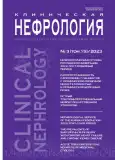Choice of surgical tactics for calculous anuria in infants
- Authors: Nasirov A.A.1, Khotamov K.N.1, Baiakhmedov F.F.1, Khoshimov T.R.2
-
Affiliations:
- Tashkent Pediatric Medical Institute
- Clinic of the Tashkent Pediatric Medical Institute
- Issue: Vol 15, No 3 (2023)
- Pages: 52-55
- Section: Nephrourology
- Published: 17.12.2023
- URL: https://journals.eco-vector.com/2075-3594/article/view/624736
- DOI: https://doi.org/10.18565/nephrology.2023.3.52-55
- ID: 624736
Cite item
Abstract
Objective. The choice of tactics of surgical treatment depending on the duration and complication of calculous anuria i n infants.
Material and methods. We followed-up 53 children aged from 4 months to 3 years. The patients were divided into 2 groups: group 1 – 35 (66%) patients with anuria duration not more than 3 days, group 2 – 18 (33.9%) patients with anuria duration more than 3 days.
Results. The choice of surgical tactics for calculous anuria in infants depended on the severity of symptoms due to the presence of concomitant and background diseases, the duration of anuria.
Conclusion. Analysis of the restoration of homeostasis after deblocking showed that the normalization of clinical and biochemical parameters in patients with a longer period of anuria (more than 3 days) was much slower than in patients with a shorter period of anuria. At the same time, the dynamics of metabolic processes depended on the duration of anuria and the severity of the patients' condition. Preliminary nephrostomy and stabilization of the condition of patients contributed to a more rapid recovery of disorders caused by anuria than after radical removal of the stone.
Keywords
Full Text
About the authors
Abdusattor A. Nasirov
Tashkent Pediatric Medical Institute
Email: abdusattornosirov405@gmail.com
ORCID iD: 0000-0002-2816-9655
Dr.Sci. (Med.), Associate Professor at the Department of Faculty Pediatric Surgery
Uzbekistan, 13 5-Khiva passage, Chilanzar district, TashkentKhusniddin N. Khotamov
Tashkent Pediatric Medical Institute
Email: husni69@mail.ru
ORCID iD: 0000-0002-1072-8922
Cand.Sci.(Med.), Associate Professor at the Department of Faculty Pediatric Surgery, Tashkent Pediatric Medical Institute
Uzbekistan, 23 Tarakkiyet st., Iykota MFY, Bektemir district, TashkentFatkhullа F. Baiakhmedov
Tashkent Pediatric Medical Institute
Email: fatxulla2004@mail.ru
ORCID iD: 0000-0002-0803-3670
Senior Lecturer at the Department of Faculty Pediatric Surgery
Uzbekistan, 3 Erkinlik 1 tor kucha Navruz MFY, Kibray district, Tashkent regionTulkin R. Khoshimov
Clinic of the Tashkent Pediatric Medical Institute
Author for correspondence.
Email: abdusattornosirov405@gmail.com
Head of the Uronephrology Department, Uronephrology Department
Uzbekistan, 81 Shohidontep st., Shaykhantokhur district, TashkentReferences
- Бачурин А.В. Современные подходы к лечению больных с постренальной острой почечной недостаточностью (клинико-экспериментальные исследования). Дисс. канд. мед. наук. Киев, 1991. [Bachurin A.V. Modern approaches to the treatment of patients with postrenal acute renal failure (clinical and experimental studies). Diss. Candidate of Medical Sciences. Kiev, 1991. (In Russ.)].
- Гузенко В.Н. Пути повышения эффективности хирургического лечения и профилактики послеоперационных осложнений у больных двусторонним нефролитиазом. Дисс. канд. мед. наук. Киев, 1989. [Guzenko V.N. Ways to improve the effectiveness of surgical treatment and prevention of postoperative complications in patients with bilateral nephrolithiasis. Diss. Candidate of Medical Sciences. Kiev, 1989. (In Russ.)].
- Джавад-Заде С.М. Современный взгляд на патогенез, течение и лечение мочекаменной болезни. Урология. 1999;5:10–12. [Javad-Zadeh S.M. Modern view on the pathogenesis, course and treatment of urolithiasis. Urologiia. 1999;5:10–12 (In Russ.)].
- Дзеранов Н.К. Лечение мочекаменной болезни: комплексная медицинская проблема. Лечащий врач. 2002;11:4–9. [Dzeranov N.K. Treatment of urolithiasis: a complex medical problem. The attending physician. 2002;11:4–9 (In Russ.)].
- Лопаткин Н.А., Яненко Э.К., Румянцев В.Б, Данилков А.П. Окклюзируюший фактор в развитии осложнений мочекаменной болезни. Урология и нефрология. 1999;1:5–7. [Lopatkin N.A., Yanenko E.K., Rumyantsev V.B., Danilov A.P. Occlusive factor in the development of complications of urolithiasis. Urology and nephrology. 1999;1:5–7 (In Russ.)].
- Насиров А.А., Байахмедов Ф.Ф., Хотамов Х.Н., Хошимов Т.Х. Послеоперационное лечение детей, больных почечной формой первичного гиперпаратиреодизма. Клиническая нефрология. 2022;2:56–58. [Nasirov A.A., Bayakhmedov F.F., Khotamov H.N., Khoshimov T.H. Postoperative treatment of children with renal form of primary hyperparathyroidism. Clinical nephrology. 2022;2:56–58 (In Russ.)].
- Хайруллаев Х. Нефролитиаз у детей раннего возраста. Дисс. канд. мед. наук. М., 1991. [Khairullaev H. Nephrolithiasis in young children. Diss. Candidate of Medical Sciences. M., 1991 (In Russ.)].
- Ольхова Е.Б., Кузнецова Е.В., Злыгарова Н.В. и др. Постренальная острая почечная недостаточность у новорожденного. Детская хирургия. 2004;4:37–41. [Olkhova E.B., Kuznetsova E.V., Zlygareva N.V., etc. Postrenal acute renal failure in a newborn. Pediatric surgery. 2004;4:37–41 (In Russ.)].
- Askenazi D.J., Ambalavanan N., Goldstein S.L. Acute kidney injury in critically ill newborns: What do we know? What do we need to learn? Pediatr. Nephrol. 2009;24:265–74.
- Hoste E., Kellum J., Acute kidney injury: epidemiology and diagnostic criteria. Curr. Opin. Crit. Care. 2006;2:531–37.
- Walters S., Porter C., Brophy P.D. Dialysis and pediatric acute kidney injure: choice or renal support modality. Pediatr. Nephrol. 2009;24:37–48.
- Аkcan-Arican А., Zappitelli M., Loftis L.L., et al. Modified RIFLE criteria in critically ill children with acute renal injure. Kidney Internat. 2007;71: 1028–35.







